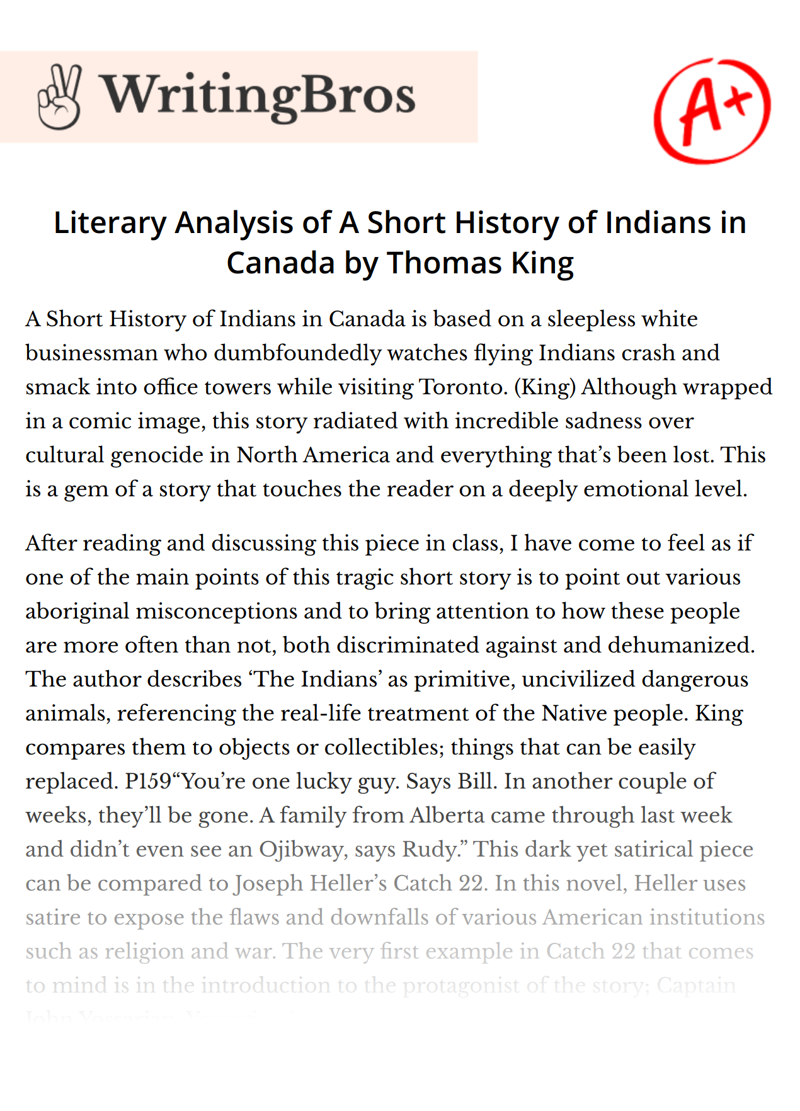Literary Analysis of A Short History of Indians in Canada by Thomas King

A Short History of Indians in Canada is based on a sleepless white businessman who dumbfoundedly watches flying Indians crash and smack into office towers while visiting Toronto. (King) Although wrapped in a comic image, this story radiated with incredible sadness over cultural genocide in North America and everything that’s been lost. This is a gem of a story that touches the reader on a deeply emotional level.
After reading and discussing this piece in class, I have come to feel as if one of the main points of this tragic short story is to point out various aboriginal misconceptions and to bring attention to how these people are more often than not, both discriminated against and dehumanized. The author describes ‘The Indians’ as primitive, uncivilized dangerous animals, referencing the real-life treatment of the Native people. King compares them to objects or collectibles; things that can be easily replaced. P159“You’re one lucky guy. Says Bill. In another couple of weeks, they’ll be gone. A family from Alberta came through last week and didn’t even see an Ojibway, says Rudy.” This dark yet satirical piece can be compared to Joseph Heller’s Catch 22. In this novel, Heller uses satire to expose the flaws and downfalls of various American institutions such as religion and war. The very first example in Catch 22 that comes to mind is in the introduction to the protagonist of the story; Captain John Yossarian. Yossarian is a young man in the military hospital who is found to be just short of having jaundice. However, in this story, the medical staff refuse to treat him as his jaundice has not yet fully developed and at the same time, also refuse to release him because they know that his state will only worsen over time.
As we know it from this classic novel, Yossarian is trapped in a ‘Catch 22’, a now common term derived from the novel, that uses satire to emphasize the time wasted in medical indecision when someone could actually be treated within that time period. The doctors want to wait until he is extremely ill, in which case treatment may no longer be effective. Throughout this novel we see these ridiculous scenarios which waste time, money and resources, which essentially add up to a waste of human life.
Similar to King’s use of satire in A Short History of Indians in Canada, Heller makes us laugh, but then as we come down from laughter, we are struck by the horror of the situations time and time again. When it comes to the theme or concept of deterioration of the Native culture, it’s obvious to see that the assimilation into the White society causes Natives to leave behind their culture. There is a loss of pride in being Native. As discussed in class recently, there have been attempts to assimilate the Native Indians by creating and enforcing reservation schools and forcing young children to attend. As a result, Native children were not able to learn the traditions and culture of their heritage. King addresses this topic in this short story by comparing the ‘Wild Indians’ to birds that are being “bagged and tagged”. He also references this in mentioning how the Indians are currently “migrating” across Toronto.
I find Thomas King to be an incredible writer. He makes his points by using analogy and takes interesting story telling and transposes it with important First Nations issues. At first glance, the message of his writing may not be completely evident because the opening scenario seems so illogical. This is because of his ‘Indian Perspective’. By reading his writing we are allowed in as guests. He shares his personal perspective by trying to help us get outside of our usual rhetoric stereotypes and presents the situations in fresh and unexpected ways.
Cite this Essay
To export a reference to this article please select a referencing style below

